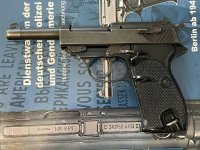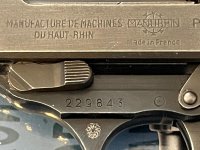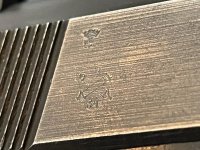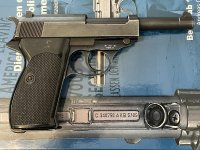Absalom
SWCA Member, Absent Comrade
This P38 variant has shown up occasionally in threads here. I’m really not buying any more guns, in fact, I should start selling for medical reasons, but … my earlier, 1921-to-1945 Berlin police P08 really needed a sidekick, so here are a few photos of my Pistolet P1, recently acquired. 

They are readily available; there are currently seven on offer at GB. Some have fantasy prices up to 1500, but the market has lately clustered between 700 and 900. I grabbed mine when I could get it for 600. Condition doesn’t vary much; the slides are often nicer on those that received the “fat slide” replacements, but the trade-off is that the gun is no longer all-original. No Berlin pistols got the hex bolt, so for strictly a shooter, you’re better off with a post-1975 Bundeswehr (W. German army) P1.
Many folks here likely know the story behind these. By the early 1960s, West German states had largely adopted 7.65mm sidearms, mostly Walther PP/PPK, a trend that was only later reversed by the urban terrorism of the 1970s. However, a special situation existed in West Berlin. Adopting the P1 was part of an informal West German plan to equip the West Berlin police, the only armed German presence in the city, to army standards so it could function as a paramilitary support force with the Western Allies’ brigades in case of attack.
To circumvent Four Powers rules prohibiting German-made guns in the city, West German-manufactured infantry arms were “Frenched” through a cooperation with French companies, which assembled, stamped and proofed the guns and had them shipped on to Berlin by the French military. Voila, guns “made in France”. The HK G3 was handled at MAS/St. Etienne, the Rheinmetall MG3 (the 7.62mm version of the Nazi MG42), Walther MP-L, and P1 (and later some P4) at Manurhin. This never fooled anyone, but since it was legal, under then-valid trade laws, the Soviets had no basis for any formal complaints.
Walther was in close cooperation with Manurhin anyways since they had manufactured the PP/PPK series for Walther since 1952, and continued to supply all the parts even after Walther was allowed to resume assembly at Ulm in 1957.
The P1 entered West Berlin service in 1963/64, replacing a menagerie of different WW II-vintage revolvers and pistols (including thousands of .38 Spl. US Victory models). Around 15,000 pistols total went to the police, customs, and corrections. Starting in 1981 they were replaced with the SigSauer P6.
SigSauer took the P1s in trade and then sold them to a number of surplus importers. Import marks are various degrees of obnoxious; the Interarms billboard on the right slide surface is my least favorite.
Regardless of what you may read, nobody has definitely solved the mystery of the crossed cannons, oddly specific with 3/34, yet. The supposed Portuguese contract is something everybody copies from each other, but evidence there is zilch.
On guns with fat replacement slides, the slides are numbered to the frame serial. But you can easily identify them: They say just “France” instead of “Made in France”, the vertical gripping grooves extend forward beyond the safety, and there is a St. Etienne crown proof on the left in front of the grooves. Very rare are late replacement slides just saying “P1 9mmx19” with no Walther banner or Manurhin logo on a Berlin frame (with police star). Those were sent directly from Ulm without the French detour.




They are readily available; there are currently seven on offer at GB. Some have fantasy prices up to 1500, but the market has lately clustered between 700 and 900. I grabbed mine when I could get it for 600. Condition doesn’t vary much; the slides are often nicer on those that received the “fat slide” replacements, but the trade-off is that the gun is no longer all-original. No Berlin pistols got the hex bolt, so for strictly a shooter, you’re better off with a post-1975 Bundeswehr (W. German army) P1.
Many folks here likely know the story behind these. By the early 1960s, West German states had largely adopted 7.65mm sidearms, mostly Walther PP/PPK, a trend that was only later reversed by the urban terrorism of the 1970s. However, a special situation existed in West Berlin. Adopting the P1 was part of an informal West German plan to equip the West Berlin police, the only armed German presence in the city, to army standards so it could function as a paramilitary support force with the Western Allies’ brigades in case of attack.
To circumvent Four Powers rules prohibiting German-made guns in the city, West German-manufactured infantry arms were “Frenched” through a cooperation with French companies, which assembled, stamped and proofed the guns and had them shipped on to Berlin by the French military. Voila, guns “made in France”. The HK G3 was handled at MAS/St. Etienne, the Rheinmetall MG3 (the 7.62mm version of the Nazi MG42), Walther MP-L, and P1 (and later some P4) at Manurhin. This never fooled anyone, but since it was legal, under then-valid trade laws, the Soviets had no basis for any formal complaints.
Walther was in close cooperation with Manurhin anyways since they had manufactured the PP/PPK series for Walther since 1952, and continued to supply all the parts even after Walther was allowed to resume assembly at Ulm in 1957.
The P1 entered West Berlin service in 1963/64, replacing a menagerie of different WW II-vintage revolvers and pistols (including thousands of .38 Spl. US Victory models). Around 15,000 pistols total went to the police, customs, and corrections. Starting in 1981 they were replaced with the SigSauer P6.
SigSauer took the P1s in trade and then sold them to a number of surplus importers. Import marks are various degrees of obnoxious; the Interarms billboard on the right slide surface is my least favorite.
Regardless of what you may read, nobody has definitely solved the mystery of the crossed cannons, oddly specific with 3/34, yet. The supposed Portuguese contract is something everybody copies from each other, but evidence there is zilch.
On guns with fat replacement slides, the slides are numbered to the frame serial. But you can easily identify them: They say just “France” instead of “Made in France”, the vertical gripping grooves extend forward beyond the safety, and there is a St. Etienne crown proof on the left in front of the grooves. Very rare are late replacement slides just saying “P1 9mmx19” with no Walther banner or Manurhin logo on a Berlin frame (with police star). Those were sent directly from Ulm without the French detour.
Attachments
-
 44123CAA-F2D6-429D-84D3-CF89B399FF9A.jpg97.2 KB · Views: 398
44123CAA-F2D6-429D-84D3-CF89B399FF9A.jpg97.2 KB · Views: 398 -
 C2D6593A-6F39-4DA6-81E8-BE97F348792F.jpg69.7 KB · Views: 394
C2D6593A-6F39-4DA6-81E8-BE97F348792F.jpg69.7 KB · Views: 394 -
 8A12FF46-CDFE-4169-B7EC-CF3B443E11AF.jpg89.7 KB · Views: 398
8A12FF46-CDFE-4169-B7EC-CF3B443E11AF.jpg89.7 KB · Views: 398 -
 1BB14DC2-A9AF-4450-8F39-9195F97DA1E7.jpg96.5 KB · Views: 390
1BB14DC2-A9AF-4450-8F39-9195F97DA1E7.jpg96.5 KB · Views: 390 -
 17C0CD85-4BB9-4D68-A6B4-612420F5E475.jpg107.2 KB · Views: 395
17C0CD85-4BB9-4D68-A6B4-612420F5E475.jpg107.2 KB · Views: 395
Last edited:










